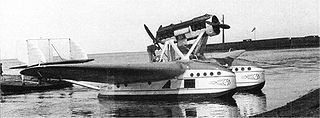
The Savoia-Marchetti S.55 was a double-hulled flying boat produced in Italy, beginning in 1924. Shortly after its introduction, it began setting records for speed, payload, altitude and range.

The CANT Z.1007 Alcione (Kingfisher) was an Italian three-engined medium bomber, with wooden structure. Designed by Filippo Zappata, who also designed the CANT Z.506 it had "excellent flying characteristics and good stability" and was regarded by some as "the best Italian bomber of World War II" although its wooden structure was easily damaged by the climate, as experienced in North Africa and in Russia. It was used by the Italian Regia Aeronautica, Italian Co-Belligerent Air Force, Aeronautica Nazionale Repubblicana and Luftwaffe during World War II.
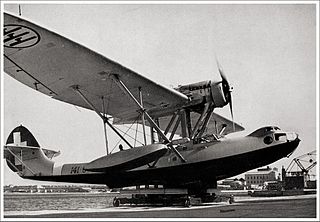
The CANT Z.501 Gabbiano was a high-wing central-hull flying boat, with two outboard floats. It was powered by an engine installed in the middle of the main-plane and had a crew of 4–5 men. It served with the Italian Regia Aeronautica during World War II, as a reconnaissance aeroplane. During its debut in 1934, it set a world distance record. It was obsolete by 1940, but was still used throughout the Second World War, suffering many losses. A few remained in service until 1949.

The Breda Ba.25 was an Italian two-seat biplane trainer designed and built by the Breda company. It was the most widely used Italian basic trainer of the 1930s.
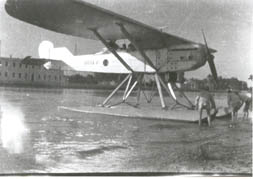
The Breda A.7 was a reconnaissance aircraft developed in Italy for use by the Regia Aeronautica in 1929. It was a braced parasol monoplane of conventional configuration with tailskid undercarriage. The pilot and observer sat in tandem, open cockpits. A single prototype of a long-range example, originally designated A.7 Raid and later A.16 was also constructed, but the air force showed no interest in it.

The Caproni Ca.135 was an Italian medium bomber designed in Bergamo in Italy by Cesare Pallavicino. It flew for the first time in 1935, and entered service with the Peruvian Air Force in 1937, and with the Regia Aeronautica in January 1938.

The SAI-Ambrosini SS.4 was an Italian fighter prototype developed in the late 1930s, featuring a canard-style wing layout and a pusher propeller. Development of the SS.4 was abandoned after the prototype crashed on its second flight.

The Savoia-Marchetti SM.78 was an Italian bomber/reconnaissance biplane flying boat of the early 1930s.

The Breda Ba.201 was an Italian dive bomber designed during World War II, that never entered production.
The Piaggio P.32 was an Italian medium bomber of the late 1930s, produced by Piaggio, and designed by Giovanni Pegna. It was a modern design for its time, but was a failure due to lack of powerplants commensurate with its high wing loading.
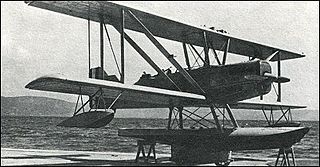
The Piaggio P.6 was an Italian catapult-launched reconnaissance floatplane designed and built by Piaggio for the Regia Marina.

The Savoia-Marchetti S.59 was a 1920s Italian reconnaissance/bomber flying boat designed and built by Savoia-Marchetti for the Regia Aeronautica.

The Caproni Vizzola F.6 was a World War II-era Italian fighter aircraft built by Caproni. It was a single-seat, low-wing cantilever monoplane with retractable landing gear. Only two prototypes were built, one designated F.6M and the other designated F.6Z.

The Caproni Ca.331 Raffica was an Italian aircraft built by Caproni in the early 1940s as a tactical reconnaissance aircraft/light bomber and also as a night fighter.
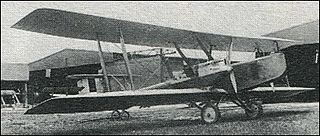
The Piaggio P.3 was an Italian night bomber prototype built by Piaggio in 1923.
The Piaggio P.23M was an Italian commercial transport aircraft prototype designed and built by Piaggio.

The Piaggio P.23R, also known as the Piaggio P.123 for propaganda purposes, was an Italian commercial transport aircraft prototype designed and built by Piaggio.

The Caproni Ca.90 was a prototype Italian heavy bomber designed and built by Caproni. When it first flew in 1929, it was the largest land-based aircraft then extant in the world, the Siemens-Schuckert R.VIII having been slightly larger.

The twin-engined CANT Z.1011 was one of two bombers of about the same size and powered by the same engines, designed by Filippo Zappata in the mid-1930s. The other was the three-engined CANT Z.1007, which in the end was the type preferred by the Regia Aeronautica.

The Asso XI was a family of water-cooled, supercharged V12 piston aeroengines produced in the 1930s by Italian manufacturer Isotta Fraschini, and fitted on a number of aircraft types built by CANT, Caproni and others.





















